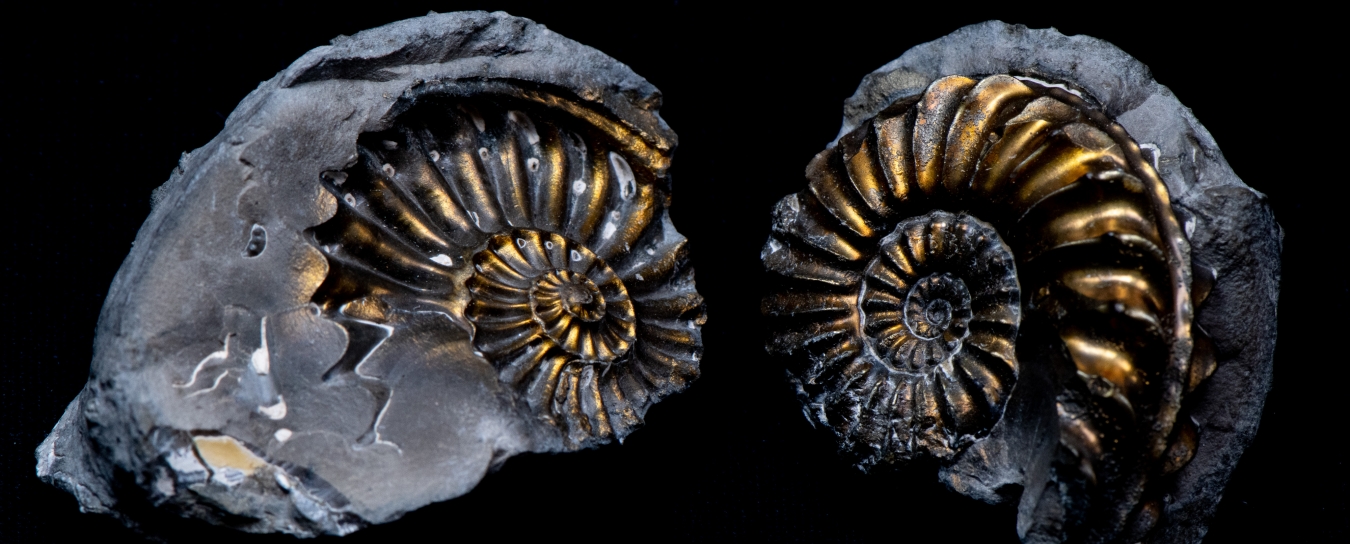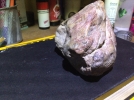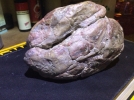
Rocks & Fossils
Check out our rock and fossil FAQ for smart collecting tips, information about some local rock formations, and advice about fossil eggs and meteorites.
- Anthropology
- Rocks & Fossils
- Invertebrates
- Vertebrates
- Botany
- Astronomy
- Fungi
- General
- Recently Asked
Interesting object found.....
I found this while digging in a creek bed on our property ( Cold Spring area) My question is, "what is it?"
Thank you for your time.


Curator Response
Hi David,
What is it? Based on your photos, it's a rock! However, you need not be disappointed; this looks like a rock with a cool history. The milky parts suggest it is chert, a cryptocrystalline (having a crystal structure so small it can only be seen when magnified) form of silica. Locally, chert is abundant in the Franciscan and Monterey Formations. These are groups of rocks with distinctive characteristics from which we can discern their relationships in time and space to adjacent rocks. The red color in your piece of chert--and where you dug it up--make it more likely to be Franciscan chert. Monterey chert forms in layers in Monterey shale, and gets its characteristic dark brown and black color from being rich in the same materials that produce all the tar, oil, and asphaltum in the Monterey Formation.
Its Franciscan origins indicate that your rock started out as a sedimentary rock formed from marine sediments deposited on the sea floor millions of years ago, during the Mesozoic, when dinosaurs roamed the earth and weird reptiles swam in the seas. Those sediments were later squeezed by two tectonic plates as one slid under the other in a process called subduction. The extreme pressure and heat generated by this subduction process changed the mineral content and texture of these rocks. In fancy science words, they were metamorphosed. When this happened, this rock was deep underground, so how did it make it up to the surface? In a word, uplift. About 18 million years ago, the land that would become Santa Barbara was actually down near the San Diego area. This bit of land broke off of the North American Plate and started slowly hitchhiking north along with the neighboring Pacific Plate.
About six million years ago, this piece riding along on the plate margin started to pivot, rotating into the position it now holds today, where it runs east-to-west, unlike the rest of the coastline. As it collided back into the rest of North America, that slow but powerful impact of land masses pushed up all the mountain ranges that run east-to-west (known as the Transverse Ranges). These include the Santa Ynez Mountains right here behind you in Montecito. The forces that pushed up those mountains pushed up their constituent rocks, including Franciscan rocks. If you are not near an area where there is an outcrop of Franciscan rocks, it could be that your rock came down the creek from an area higher up in the mountains. This is all to say that this rock has taken a long journey to arrive with you.
You are not the only human to be interested in a piece of chert, either. Franciscan chert was commonly used by the Chumash people as raw material to fashion projectile points and other stone tools. This use for chert is reflected in the fact that some people use the word "chert" interchangeably with the word "flint," while others note a distinction in how the two kinds of rocks are formed. Before this gives you any ideas about taking a whack at this rock to test your flintknapping skills, beware of two things: 1) although it's a rewarding hobby, flintknapping is very dangerous because you are working with materials that literally create razor-sharp edges, and 2) water-tumbled cobbles like the one in your picture tend to be full of tiny fractures, which make them difficult to knap predictably.
Thank you for sharing your interesting rock with us.
Stay curious,
Dibblee Curator of Earth Science Jonathan Hoffman, Ph.D., Associate Curator of Anthropology Brian Barbier, M.A., and two bonus geologists: Nature Education Manager Sabina Thomas, Ph.D., and Teen Programs Manager Jenna Rolle, M.S.
David response:
Thank you for your tlme. I'm a little embarrassed that I asked, but, now, I know what I have, is a rock.
Curator response:
Please don't be embarrassed! You gave us an excuse to talk about some of our favorite things.

